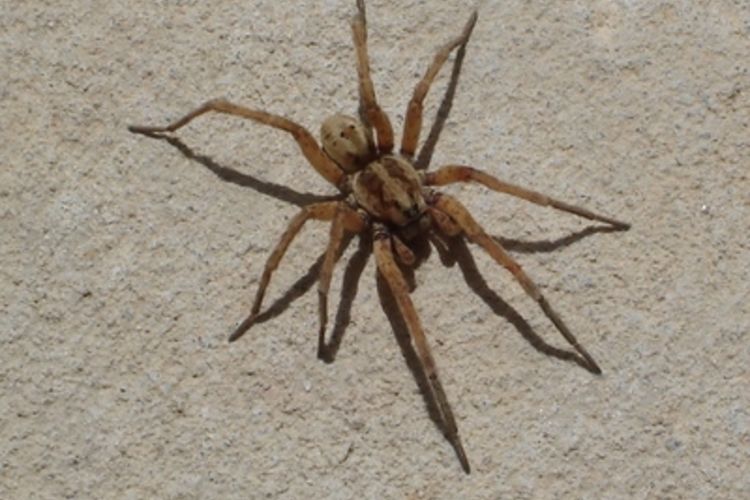|
 Spiders
have a well-established but largely
undeserved reputation as being
dangerous to the health of people
and their pets. In truth, spiders
are extremely beneficial because
they prey on many insects that we
consider to be true pests in our
homes and gardens. Not all spiders
build elaborate webs to catch their
prey. Some species ambush their prey
from tubular tunnels built in the
ground, under rocks or other areas.
Other species simply build a loose
collection of webbing in which they
live. These types of spiders, such
as the wolf spider shown here, are
the ones that most frequently invade
homes. They may remain hidden for
most of the day, then hunt for prey
at night. Spiders
have a well-established but largely
undeserved reputation as being
dangerous to the health of people
and their pets. In truth, spiders
are extremely beneficial because
they prey on many insects that we
consider to be true pests in our
homes and gardens. Not all spiders
build elaborate webs to catch their
prey. Some species ambush their prey
from tubular tunnels built in the
ground, under rocks or other areas.
Other species simply build a loose
collection of webbing in which they
live. These types of spiders, such
as the wolf spider shown here, are
the ones that most frequently invade
homes. They may remain hidden for
most of the day, then hunt for prey
at night.
Biology of spiders
 Spiders
are not insects. They are close
relatives of ticks, mites and
scorpions, which all belong in the
group called arachnids. Unlike
insects, which have three main body
sections and six legs, spiders have
two body sections and eight legs.
The eyes, mouthparts and legs are
found on the front section of the
body, known as the cephalothorax.
The second section, the abdomen,
bears the parts of the respiratory
system (spiracles and/or book lungs
depending on the type of spider),
the digestive and reproductive
systems, and the external organs
used for spinning silk or webbing.
Most spiders are identified by size,
color, markings on the body and the
number (usually six or eight) and
arrangement of eyes. Female spiders
wrap their eggs in a silken spun
sac. Some spiders carry this egg
sac, while others deposit it
somewhere within their nest.
Hatchling spiders (spiderlings)
often produce a silk thread that
allows them to disperse by
"ballooning", i.e., being blown by
wind currents to other areas. Spiders
are not insects. They are close
relatives of ticks, mites and
scorpions, which all belong in the
group called arachnids. Unlike
insects, which have three main body
sections and six legs, spiders have
two body sections and eight legs.
The eyes, mouthparts and legs are
found on the front section of the
body, known as the cephalothorax.
The second section, the abdomen,
bears the parts of the respiratory
system (spiracles and/or book lungs
depending on the type of spider),
the digestive and reproductive
systems, and the external organs
used for spinning silk or webbing.
Most spiders are identified by size,
color, markings on the body and the
number (usually six or eight) and
arrangement of eyes. Female spiders
wrap their eggs in a silken spun
sac. Some spiders carry this egg
sac, while others deposit it
somewhere within their nest.
Hatchling spiders (spiderlings)
often produce a silk thread that
allows them to disperse by
"ballooning", i.e., being blown by
wind currents to other areas.
How dangerous are spiders?
 Encounters
between people and spiders are
usually accidental and bites are a
response by the spider when its web
or nest is disturbed. Most spiders
produce venom therefore, they could
be considered "poisonous". The venom
is stored in glands that empty into
the spider's fangs or chelicerae.
For the most part, spider bites are
insignificant. However, just as bee
and wasp stings may trigger allergic
reactions in some people, the same
can be true for spider bites. Young
children, the elderly and
hypersensitive individuals are more
likely to react more strongly to a
spider bite. In North Carolina,
there are few spiders that can
inflect serious and painful injury.
The two best-known poisonous spiders
found here are the black widow
spider and the brown recluse. Encounters
between people and spiders are
usually accidental and bites are a
response by the spider when its web
or nest is disturbed. Most spiders
produce venom therefore, they could
be considered "poisonous". The venom
is stored in glands that empty into
the spider's fangs or chelicerae.
For the most part, spider bites are
insignificant. However, just as bee
and wasp stings may trigger allergic
reactions in some people, the same
can be true for spider bites. Young
children, the elderly and
hypersensitive individuals are more
likely to react more strongly to a
spider bite. In North Carolina,
there are few spiders that can
inflect serious and painful injury.
The two best-known poisonous spiders
found here are the black widow
spider and the brown recluse.
Tips on Avoiding Spider Bites
Follow these
suggestions to reduce the chances of
being bitten:
-
Always check
for spiders before sticking your
bare hand(s) into dark corners
or areas where you can't see
your fingertips.
-
Always wear
work gloves when handling boxes,
firewood, lumber and other items
that have been left in storage
undisturbed for significant
periods of time.
-
Vigously
shake clothing and shoes that
have been left undisturbed for
some time to dislodge any
spiders and inspect them before
wearing.
-
If you think
you have been bitten by either a
black widow spider or brown
recluse, carefully apply ice or
a cold-pack to the bite and seek
medical assistance. If you can
catch the suspect spider, bring
it along for positive
identification.
|
